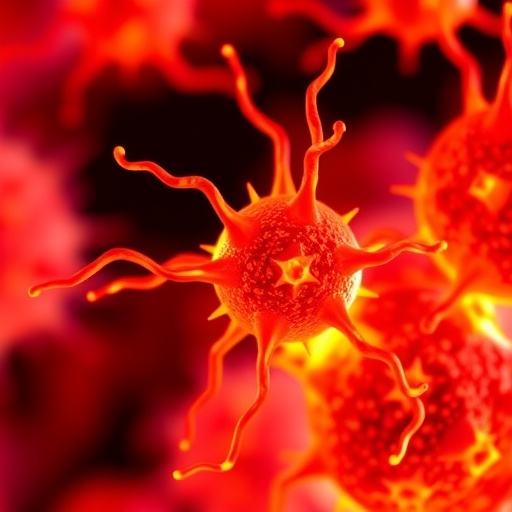A groundbreaking study conducted by researchers at the Seville Biomedical Institute (IBiS) has unveiled a novel molecular mechanism that underpins the marked sensitivity of Ewing sarcoma—a highly aggressive bone cancer primarily affecting children and adolescents—to certain chemotherapeutic agents, notably irinotecan. This pioneering research, recently published in the prestigious journal Oncogene, charts a new course toward personalized and more effective therapeutic strategies tailored for this formidable malignancy.
Ewing sarcoma is distinguished by a unique genetic aberration involving the fusion of the EWSR1 and FLI1 genes. This fusion event engenders a chimeric oncoprotein, EWS::FLI1, which acts as a potent oncogenic driver by not only initiating tumorigenesis but perpetuating tumor growth and progression. The fusion protein exerts disruptive effects on crucial cellular processes, a facet that the IBiS research team has now meticulously deciphered in connection to the tumor cells’ vulnerability.
At the heart of this vulnerability lies an intricate interplay between the chimeric EWS::FLI1 protein and the RNA helicase DHX9. The study reveals that EWS::FLI1 seizes DHX9, effectively incapacitating its physiological role in resolving R-loops—three-stranded nucleic acid structures formed during transcription when the newly synthesized RNA hybridizes with the DNA template strand, leaving the non-template strand single-stranded. The pathological accrual of R-loops instigates genomic instability and replication stress, rendering the tumor cells more susceptible to lethal DNA damage.
Crucially, treatment with irinotecan, a topoisomerase I inhibitor widely employed in chemotherapeutic regimens, exacerbates the accumulation of R-loops within the Ewing sarcoma cells. Topoisomerase I is indispensable for alleviating DNA supercoiling during replication and transcription. Inhibition by irinotecan results in sustained DNA damage and cytotoxicity, an effect now mechanistically explained by the impairment of DHX9’s R-loop resolution function due to its sequestration by EWS::FLI1. This synergy leads to catastrophic replication stress and eventual apoptotic cell death in the tumor.
“This mechanistic insight identifies a precise molecular Achilles’ heel in Ewing sarcoma, opening therapeutic avenues that exploit this susceptibility,” stated Dr. Fernando Gómez-Herreros, senior researcher at IBiS and co-leader of the study. He highlights that targeting the disturbed R-loop metabolism not only elucidates why Ewing sarcoma displays heightened sensitivity to irinotecan but also suggests the potential of combining irinotecan with ATR inhibitors. ATR, a key kinase activated by replication stress, represents a promising target to amplify cytotoxicity in these cancer cells by further compromising their DNA damage response mechanisms.
Further bolstering the translational potential of the findings, the researchers found that elevated DHX9 expression in patient tumors correlates with poorer clinical outcomes, indicating that DHX9 levels could serve as a prognostic biomarker. This biomarker could refine patient stratification and therapeutic tailoring, enhancing precision medicine in the clinical management of Ewing sarcoma. Moreover, pharmacological or genetic disruption of the EWS::FLI1-DHX9 interaction appears to mitigate the accumulation of genomic damage and confer resistance to irinotecan, underscoring the functional importance of this molecular liaison.
Dr. Enrique de Álava, head of the Pathology Department at Virgen del Rocío University Hospital and principal investigator at IBiS, emphasized the clinical implications, “Our discovery explains the remarkable response seen in subsets of patients treated with irinotecan and provides a molecular framework to design refined clinical trials involving rational combinational treatments. In a cancer as complex and devastating as Ewing sarcoma, enhancing treatment precision could significantly tilt the balance toward improved survival rates.”
The study exemplifies the power of collaborative, multidisciplinary research, involving an extensive network of institutions across Spain, Germany, and Italy. Contributions came from national centers including CIBERONC, the Carlos III Health Institute, and the University of Valencia, as well as international partners such as the German Cancer Research Center (DKFZ), the Hopp Children’s Cancer Center in Heidelberg, and the IRCCS Rizzoli Orthopaedic Institute in Bologna. This unified effort underscores the global commitment to tackling pediatric sarcomas poised to transform clinical outcomes.
Facing the challenges posed by Ewing sarcoma’s genomic complexity, this research signifies a leap forward by identifying a tangible molecular vulnerability centered on R-loop metabolism dysfunction. Future therapeutic regimens could capitalize on this Achilles’ heel through agents that enhance replication stress or impair compensatory DNA repair pathways, potentially revolutionizing the therapeutic landscape for this malignancy.
Subsequent investigations are anticipated to dissect additional molecular interactions influenced by EWS::FLI1 and explore the therapeutic benefit of concomitant ATR inhibitor use in preclinical and clinical settings. Such studies will be critical to validating the translational efficacy of these findings and optimizing treatment protocols that exploit these specific molecular deficiencies.
This discovery marks an important milestone not only for understanding the biological intricacies of Ewing sarcoma but also for the evolving paradigm of targeted cancer therapy, where exploiting unique tumor biology can yield selective and potent treatment strategies. By integrating molecular pathology with clinical oncology, this research paves the way for more optimistic prognoses amidst the ongoing battle against aggressive sarcomas.
–––––––––––––––––––––––––––––––––––––––––––––––––––––––––––––––––––––––
Subject of Research: Molecular mechanisms underlying Ewing sarcoma’s sensitivity to chemotherapy, specifically the interaction between EWS::FLI1 and DHX9 impacting R-loop metabolism.
Article Title: EWS::FLI1-DHX9 interaction promotes Ewing sarcoma sensitivity to DNA topoisomerase 1 poisons by altering R-loop metabolism
News Publication Date: 28-Jul-2025
Web References: 10.1038/s41388-025-03496-9
Keywords: Ewing sarcoma, R-loops, EWS::FLI1 fusion protein, DHX9 RNA helicase, irinotecan, topoisomerase I inhibitor, genomic instability, replication stress, ATR inhibitors, targeted therapy, pediatric bone cancer, molecular vulnerability




